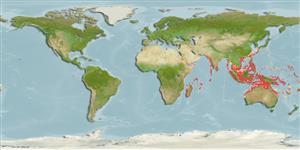Preferred temperature (Ref.
115969): 24.5 - 28.6, mean 27.8 (based on 320 cells).
Phylogenetic diversity index (Ref.
82804): PD
50 = 0.5000 [Uniqueness, from 0.5 = low to 2.0 = high].
Bayesian length-weight: a=0.01148 (0.00756 - 0.01743), b=3.02 (2.90 - 3.14), in cm Total Length, based on LWR estimates for this species & Genus-body shape (Ref.
93245).
栄養段階 (Ref.
69278): 4.0 ±0.66 se; based on food items.
回復力 (Ref.
120179): 手段, 1.4年~4.4年の倍増期間の最小個体群 (K=0.3).
Fishing Vulnerability (Ref.
59153): Low to moderate vulnerability (33 of 100).
